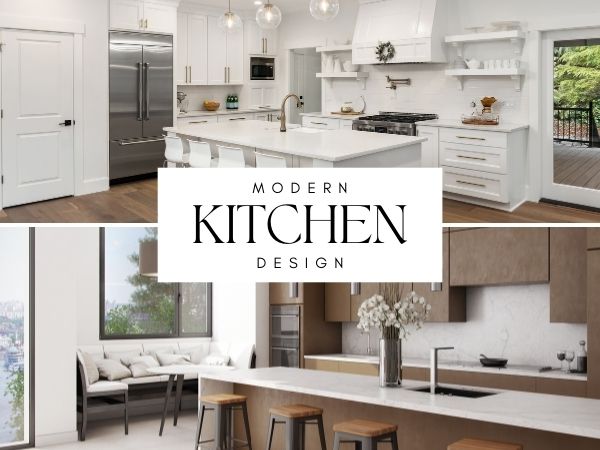1. Traditional Indian Design Touches
Before diving into modern aesthetics, let’s celebrate some quintessential traditional Indian design ideas that bring authenticity to your kitchen.
Handcrafted Wooden Cabinets
Traditional Indian kitchens often feature solid wood cabinetry, crafted with intricate designs. Whether it’s teak, rosewood, or sheesham, these cabinets not only provide durability but also add warmth to the space. Consider natural wood finishes or even distressed paint for a rustic, old-world charm.
Brass and Copper Accessories
Utensils made of brass and copper have been staples in Indian households for generations. From large spice containers to water storage pots, adding brass or copper elements to your kitchen enhances the traditional vibe. You can also incorporate these metals into light fixtures, cabinet handles, or decorative items.
Open Shelving for Utensils and Spices
Indian kitchens thrive on accessibility. Open shelving to store spices, masalas, and frequently used cookware is a nod to traditional kitchens. Use ceramic jars, glass containers, or brass tins to keep the shelves organized while maintaining a touch of elegance.
Decorative Tiles or Backsplash
A tiled backsplash with traditional Indian patterns—like Jaipuri designs or Moroccan-inspired motifs—adds an artistic touch. Opt for hand-painted or mosaic tiles to infuse character and uniqueness into your cooking space.
2. Modern Design Ideas For Functionality And Style
Modern Indian kitchens are all about optimizing space and functionality without compromising style. Here’s how you can introduce contemporary elements to balance tradition.
Modular Kitchen Layouts
The modular kitchen is a must-have in today’s urban homes. It ensures maximum space utilization with organized cabinets, pull-out drawers, and pantry units. Sleek finishes like matte or glossy laminates paired with soft-closing mechanisms bring convenience and modernity to your kitchen.
Smart Storage Solutions
Modern Indian kitchens embrace innovative storage techniques. Think of carousel corner units, pull-out spice racks, or vertical dividers for baking trays. Such solutions ensure that no corner of your kitchen goes unused while maintaining a clutter-free environment.
Quartz or Granite Countertops
Quartz and granite countertops are popular in modern kitchens for their durability, easy maintenance, and sleek look. Choose a neutral shade to complement wooden cabinets or brighter colors for a more vibrant setup. These surfaces are ideal for withstanding heavy-duty Indian cooking.
Minimalistic Lighting Design
Say goodbye to old-school tube lights and welcome layered lighting. Under-cabinet LED strips provide task lighting, while pendant lights over an island or dining space add a decorative element.
Smart Appliances
Equip your kitchen with the latest appliances—smart ovens, multi-cookers, or intelligent chimneys that can adjust to Indian cooking fumes. Not only do they enhance efficiency, but they also add a futuristic appeal to your kitchen.
3. Blending Traditional And Modern Styles
The real magic happens when traditional elements meet modern design. Here’s how you can strike the perfect balance:
Traditional Flooring with Modern Finishes
Traditional flooring materials like terracotta or kota stone are excellent options for maintaining an authentic look. To modernize the space, you can polish these surfaces or pair them with contrasting contemporary cabinetry.
Statement Ceiling Designs
Ceilings are often overlooked, but they can be a game-changer. Add a wooden beam design or jali-style false ceiling for a traditional touch, while ensuring the lighting fixtures follow a minimalist, modern theme.
Mixing Textures and Colors
Combine earthy, natural tones like ochre, terracotta, or beige with modern accents like white, grey, or navy. Experiment with a mix of textures—smooth quartz countertops, glossy cabinets, and rough stone backsplashes—to create a layered yet cohesive look.
Customized Furniture and Seating
Incorporating traditional seating like wooden stools or charpais with a modern breakfast counter can enhance your kitchen’s charm. Custom-made furniture allows you to incorporate Indian craftsmanship while ensuring it suits modern ergonomic needs.
4. A Few Pro Tips For Indian Kitchens
Here are some tips to ensure your kitchen is as functional as it is beautiful:
- Ventilation Matters: Install large windows or a powerful chimney to combat smoke and heat from tadkas and deep frying.
- Durable Materials: Opt for heat- and stain-resistant materials, as Indian cooking often involves heavy use of spices and oils.
- Easy-to-Clean Surfaces: Choose finishes that are easy to wipe down, especially for countertops, tiles, and cabinets.
- Space Planning: Keep essential cooking elements—like the stove, sink, and refrigerator—in a triangle layout for maximum efficiency.
So, take a step back, evaluate your kitchen, and see if it’s missing out on any of these ideas. With the right balance of old and new, your kitchen can be a masterpiece that reflects your style and the richness of Indian culture.

